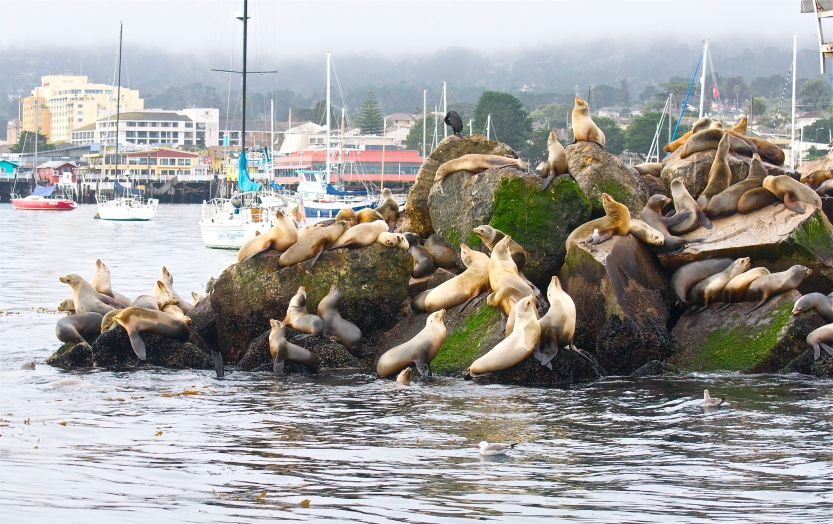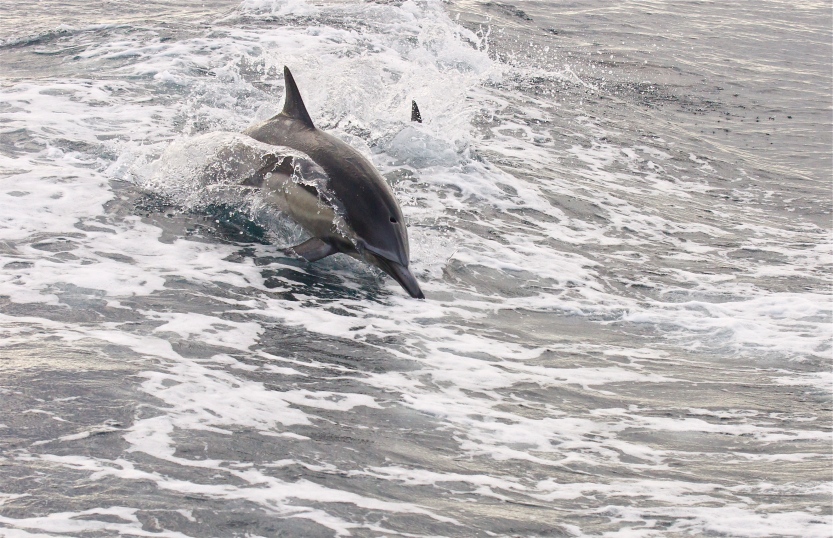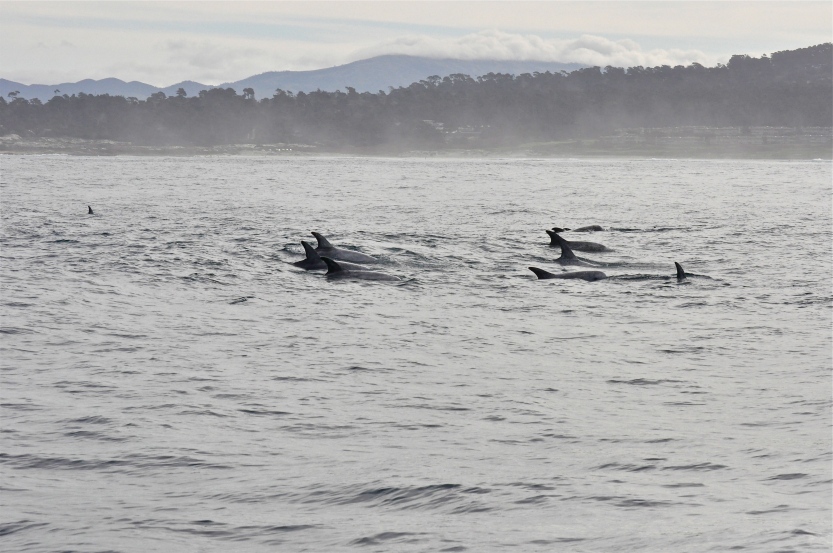On a cold January morning in Monterey Bay, California, I boarded a whale watching vessel in the hope of catching an early glimpse of Grey whales, making their great southern migration. As the boat cast-off and began to trundle through the harbour, the rhythmic sound of engine knock was disrupted by the barking of California sea lions, waving us out from the harbour wall. The boat picked up speed and the cool air, heavy with moisture from the misty rain, chilled my face. I took another slurp of hot, strong black coffee.

It was not the best time of year or the best weather conditions for whale watching, and it certainly was not the best light for photography, as the heavy sky showed its full 50 shades of grey. Nevertheless, I was optimistic that I would see some marine mammals, and pelagic birds. We were not long into the journey when the first of the cetacea broke the surface. The Long-beaked Common dolphins had appeared.

Over the next few hours I was fortunate to spend some time with the Common dolphins, a couple of Grey whales and a young male Humpback whale. A sentence in a blog post doesn’t do justice to the enormous privilege that it is to experience an encounter with these ocean-going creatures.
As we turned south to cross the bay, a different species of dolphin appeared, as a group of fins simultaneously broke the surface. These fins belonged to a pod of Risso’s dolphin.

Despite taking many boat trips, in various countries, in search of marine wildlife I had never seen a Risso’s dolphin. This is a surprise due to the fact that these are one of the most widespread dolphins, occurring in both temperate and tropical waters.
The first thing that I noticed about the Risso’s dolphin was the high, curving dorsal fins. The next thing was what appeared to be a slower, more serene movement through the water. This was in clear contrast to the fast, erratic, shorter finned Common dolphins. As the Risso’s dolphins started to break the surface, curiously, to study the contents of the boat above them, they reveal their blunt-nose faces.

The next thing that I noticed was the white face and mottled, streaked body, with colouration ranging from dark grey through to white. This is not the dolphin’s natural colour. Risso’s dolphins are born a uniform grey colour, but their diet of large, aggressive squid, who defend themselves to their certain death, with beaks and tentacles, leave them scarred with swirling lines and white skin. The older the dolphin, the whiter the colouration.

Risso’s dolphin is one of the largest dolphins, weighing in at over 1000 lbs. (500 kg) and growing to over 15 feet (3.8 m) in length. With the exception of the Orca, it is the largest dolphin to visit the Monterey Bay Area. This species usually spends its life beyond the continental shelves of the world, in the great open ocean. It is thought that up-swelling current over an uneven bottom of Monterey Bay, produces feeding opportunities that usually only exist further from shore. Recent estimates suggest that around 15,000 Risso’s dolphins live off the coast of Caifornia.


I never get tired of seeing dolphins, whether from a boat or the beach. It is always a special moment as they surface, that I cannot tear my eyes from. But so far, for me, the Risso’s dolphin has been my favourite dolphin sighting. It is definitely worth a trip to Monterey Bay, to see these unusual dolphins so close to the shore.
I didn’t head out on to the water that morning to see Risso’s dolphins and if truth be told, I didn’t know anything about them until I saw them. As it turned out, I couldn’t help but feel a little disappointed to leave behind these wonderful creatures to continue our hunt for their larger cousins, the great whales.
If you enjoyed this post, please follow Incidental Naturalist.
Comments below are welcomed.
Help others to connect with wildlife experiences by sharing this post on social media.
Categories: USA





Great post David. I’ve enjoyed a few pelagic day trips on Monterey Bay, and what a great day that is. The Risso’s are especially unique, and your photos here show them well. Interesting info too.
LikeLiked by 1 person
Thanks for the kind comment! Really I think that a Monterey Bay trip is one of the best urban wildlife experiences a person can have. A couple of hours out of San Francisco for a real rich environment.
LikeLiked by 2 people
Great story and pictures! Last month, we left out of Moss Landing on our first whale watching trip. We were treated to a spectacular display by a group of demonstrative humpbacks. Unfortunately, we did not see any dolphins, but found several later, just cruising just beyond the breakers. Next time, I will look for Risso’s. They are a beautiful species.
LikeLiked by 1 person
Thanks for the comment! Fantastic that you had an amazing whale experience. I find myself getting a little addicted to whale watching. Such an awesome experience!
LikeLike
Such beautiful writing about a beautiful subject. I know what you mean about a line in a blog post not being able to capture the awe. Thank you.
LikeLiked by 1 person
Thank you for the wonderful feedback!
LikeLike
I had never heard of a Risso nor would have known about the squids and coloring. VERY cool! I learn a lot from your posts sir!
LikeLike
Thanks for the comment, Tony! These guys are a pretty well kept secret.
LikeLiked by 1 person
I find your description of the scarring especially interesting. My daughter is an expert in the study of (giant and colossal) squid, and they are the cause of the tremendous scarring that is commonly found on the heads of sperm whales, as they (the squid) are their (the whales’) favorite food. What a fascinating field of study!
LikeLiked by 1 person
Thanks for the comment, that is very interesting. We can only imagine the kind of battles that take place between whale and giant squid at incredible depth and pressure. Your daughter certainly has a fascinating field of study.
LikeLike
I didn’t know this kind of dolphin lived along the CA coast! Interesting…and wonderful “)
LikeLiked by 1 person
Having always associated the dolphins with the bottlenosed ones I’ve grown familiar by a whole childhood spent watching Flipper, I’m now surprised to see these Risso dolphins… Brilliant blog, I’m now hooked (ha ha).
Fabrizio
LikeLiked by 1 person
I hear you! It was quite a shock when I first realised that no all dolphins have long noses. 🙂 Thanks for the kind words and I’m delighted that you’re hooked! Love the name of your blog, and I am also that travel obsessed guy at the back of the plane, so the wing doesn’t block my view, with the shade up over Baffin Island or some such place.
LikeLiked by 1 person
Ah, Baffin Island! I’ve always wanted to go there (it must be the shape of the island, seems a cat strewn above Canada, doesn’t it?). Have you been there?
Fabrizio
LikeLiked by 1 person
No, but it is on the list of possible frozen north trips while I find myself living in North America.
LikeLiked by 1 person
Lucky you!
LikeLike
Still imagining the battle for life that goes on between the Risso’s dolphins and squid. What incredible photos. The American Cetacean Society states that the size of the squid prey are unknown, but that beaks of squids that grow over 12 feet long have been found in the stomachs of stranded Risso’s. The dolphins have less than 7 pairs of teeth in the lower jaw and typically none in the upper jaw. Pods of Risso’s are usually 3-30 but “super-pods” of several thousand have been noted. While I love whale watching too, I am so glad you encountered this fascinating creature.
LikeLiked by 1 person
Thank you for the kind comment, and for contributing some great additional information for myself and others to learn from. It is amazing to imagine the battle between squid and dolphin, especially considering that the same battle usually takes place between Sperm whales and giant squid!
LikeLiked by 1 person
It’s incredible to think that that coloration comes from squid attacks! Thank you for sharing that tidbit!
I’ve just moved to southern Brazil, where we have numerous dolphin species. I don’t think the season is right for seeing them now, but I’m really hoping to catch a glimpse of a southern right whale dolphin later in the year. They look like orcas. Who knew?
LikeLiked by 1 person
Thanks for the comment! Yes, they really do look like little grey orca. I envy you having the wildlife of southern Brazil available to you! 🙂
LikeLiked by 1 person
Stumbled across this post while looking up information for a post of my own. Great write up. It is always so exciting when they are in the bay. I use to volunteer at the aquarium, and it was always exciting to see them off the deck during squid season. I would add one thing. While squid can leave some gnarly scars, they also get them from social interaction too. Dolphins of all kinds have a behavior called raking, and Risso’s seem to get many of their scars from other dolphins.
LikeLiked by 1 person
Hi Kristen, thanks for the kind, and informative comment. It is interesting to read about other ways that the Risso’s dolphin gets those distinctive scars. I’m glad that chance brought you to my blog! Best wishes, David
LikeLike